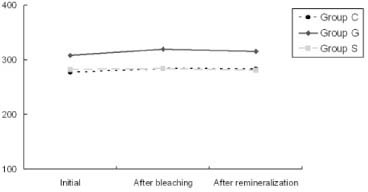J Korean Acad Conserv Dent.
2006 Nov;31(6):470-476. 10.5395/JKACD.2006.31.6.470.
The effects of tooth bleaching agents on microhardness of enamel in situ
- Affiliations
-
- 1Department of Conservative Dentistry, College of Dentistry, Kangnung National University, Korea. drbozon@kangnung.ac.kr
- KMID: 1986890
- DOI: http://doi.org/10.5395/JKACD.2006.31.6.470
Abstract
- The objective of this in situ study was to evaluate the effects of whitening strip (Claren, LG Household & Health Care Ltd, 2.6% hydrogen peroxide) and gel (Opalescence, Ultradent, 10% carbamide peroxide) on microhardness of enamel in comparison with untreated control. Extracted twenty human upper incisors were disinfected, cleaned, and labial side of each incisor sectioned into 3 fragments by 2 x 2 mm size. After sectioning, labial sides of fragments were flattened and fixed to orthodontic bracket using flowable composite resin. Specimens prepared from each tooth were attached to the labial side of upper incisors of twenty volunteers one by one and treated by three different methods: (1) untreated control (2) treated with whitening strip for 14 days (3) treated with whitening gel for 14 days. Microhardness (Microhardness tester, Zwick) of each specimen was measured at the baseline of pre-treatment, immediate after bleaching treatment, 14 days after bleaching treatment and Knoop Hardness Number was determined. Microhardness changes of experimental groups were compared. The results show that tooth whitening strip and gel used in this study does not effect the micro-hardness of enamel during bleaching procedure.
Keyword
MeSH Terms
Figure
Cited by 1 articles
-
Effect of the bleaching light on whitening efficacy
Jong-Hyun Park, Hye-Jin Shin, Deok-Young Park, Se-Hee Park, Jin-Woo Kim, Kyung-Mo Cho
J Korean Acad Conserv Dent. 2009;34(2):95-102. doi: 10.5395/JKACD.2009.34.2.095.
Reference
-
1. Heymann HO. Nonrestorative treatment of discolored teeth: reports from an International Symposium. J Am Dent Assoc. 1997. 128(6):710–711.2. Haywood VB. History, safety, and effectiveness of current bleaching techniques and applications of the nightguard vital bleaching technique. Quintessence Int. 1992. 23(7):471–488.3. Gerlach RW. Shifting paradigms in whitening: introduction of a novel system for vital tooth bleaching. Compend Contin Educ Dent Suppl. 2000. (29):S4–S9.4. Goldstein GR, Kiremidjian-Schumacher L. Bleaching: is it safe and effective? J Prosthet Dent. 1993. 69(3):325–328.
Article5. Gherilyn GS, Jacinthe MP, Robert SW. Tooth-whitening modalities for pulpless and discolored teeth. Pathways of the Pulp. 2002. 8th ed. St Louis: Mosby;749–762.6. Park DY, Jung SH, Ma DS, Chang SY, Yun SY. Randomized controlled clinical trial of the efficacy and safety of a 2.6% hydrogen peroxide containing tooth-whitening strips. J Korean Acad Dent Health. 2002. 26(3):385–396.7. Gerlach RW, Barker ML, Sagel PA. Comparative efficacy and tolerability of two direct-to-consumer tooth whitening systems. Am J Dent. 2001. 14(5):267–272.8. Featherstone JD, Ten Cate JM, Shariati M, Arends J. Comparison of artificial caries-like lesions by quantitative microradiography and microhardness profiles. Caries Res. 1983. 17(5):385–391.
Article9. Savarino L, Saponara TA, Tarabusi C, Breschi L, Prati C. Enamel microhardness after in vitro demineralization and role of different restorative materials. J Biomater Sci Polym Ed. 2002. 13(3):349–357.
Article10. Lussi A, Jaggi T, Scharer S. The influence of different factors on in vitro enamel erosion. Caries Res. 1993. 27(5):387–393.
Article11. Seghi RR, Denry I. Effects of external bleaching on indentation and abrasion characteristics of human enamel in vitro. J Dent Res. 1992. 71(6):1340–1344.
Article12. White DJ, Kozak KM, Zoladz JR, Duschner HJ, Gotz H. Effects of Crest Whitestrips bleaching on surface morphology and fracture susceptibility of teeth in vitro. J Clin Dent. 2003. 14(4):82–87.13. Basting RT, Rodrigues JA, Serra MC. The effects of seven carbamide peroxide bleaching agents on enamel microhardness over time. J Am Dent Assoc. 2003. 134(10):1335–1342.
Article14. Rodrigues JA, Basting RT, Serra MC, Rodrigues AL. Effects of 10% carbamide peroxide bleaching materials on enamel microhardness. Am J Dent. 2001. 14(2):67–71.15. Basting RT, Rodrigues AL, Serra MC. The effect of 10% carbamide peroxide bleaching material on microhardness of sound and demineralized enamel and dentin in situ. Oper Dent. 2001. 26(6):531–539.16. Justino LM, Tames DR, Demarco FF. In situ and in vitro effects of bleaching with carbamide peroxide on human enamel. Oper Dent. 2004. 29(2):219–225.17. Potocnik I, Kosec L, Gaspersic D. Effect of 10% carbamide peroxide bleaching gel on enamel microhardness, microstructure, and mineral content. J Endod. 2000. 26(4):203–206.
Article18. Araujo EM, Baratieri LN, Vieira LC, Ritter AV. In situ effect of 10% carbamide peroxide on microhardness of human enamel: function of time. J Esthet Restor Dent. 2003. 15(3):166–173.
Article19. Feagin F, Sierra O, Thiradilok S, Jeansonne B. Effects of fluoride in remineralized human surface enamel on dissolution resistance. J Dent Res. 1980. 59(6):1016–1021.
Article20. Pickel FD, Cort W, Starr N, Bilotti A, Pigman W. Evaluation of enamel-rehardening agents in saliva. J Dent Res. 1965. 44(5):855–859.
Article21. Leonard RH, Bentley CD, Haywood VB. Salivary pH changes during 10% carbamide peroxide bleaching. Quintessence Int. 1994. 25(8):547–550.22. Meredith N, Sherriff M, Setchell DJ, Swanson SA. Measurement of the microhardness and Young's modulus of human enamel and dentine using an indentation technique. Arch Oral Biol. 1996. 41(6):539–545.
Article
- Full Text Links
- Actions
-
Cited
- CITED
-
- Close
- Share
- Similar articles
-
- Evaluation of the effects of whitening mouth rinses combined with conventional tooth bleaching treatments
- Surface Damage and Bleaching Effect according to the Application Type of Home Tooth Bleaching Applicants
- Effect of dental bleaching on the microhardness and surface roughness of sealed composite resins
- Effect of three nanobiomaterials on microhardness of bleached enamel
- The effect of various commercially available bleaching agents on the microshear bond strength of composite resin to enamel


